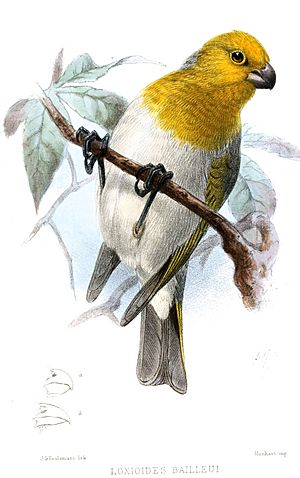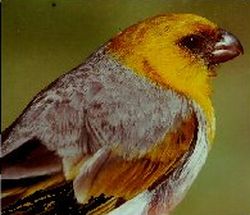Palila facts for kids
Quick facts for kids Palila |
|
|---|---|
 |
|
| Conservation status | |
| Scientific classification | |
| Genus: |
Loxioides
|
| Species: |
bailleui
|
| Synonyms | |
|
|
The palila (Loxioides bailleui) is a special type of Hawaiian honeycreeper bird. It is known for its golden-yellow head and chest, a light belly, a gray back, and greenish wings and tail. This bird is in great danger of disappearing forever, which means it is a critically endangered animal. The palila has a very close connection with the māmane tree (Sophora chrysophylla). Sadly, the destruction of these trees and the dry forests where they live has put the palila in danger. The first palila was found in 1876 on the Big Island by Pierre Étienne Théodore Ballieu.
Contents
About the Palila
Hawaiian honeycreepers, like the palila, are sometimes grouped with the true finch family. A scientist named Oustalet officially described the palila in 1877. He gave it the scientific name Loxioides bailleui. For a while, it was thought to be part of another group of Hawaiian honeycreepers. The native Hawaiian name ʻōʻū poʻopapale might also refer to this bird. Even though its beak and habits are a bit like another bird called the ʻōʻū, its colors show it is closely related to birds in the Telespiza group.
What the Palila Looks Like
The palila has a bright yellow head and chest. Its belly is white to light gray, and its back is medium gray. Its wings and tail are olive-green. This bird also has a strong, dark beak with wide sides, brown eyes, and dark feet with yellowish bottoms. The palila is one of the biggest living Hawaiian honeycreepers. It measures about 15 to 19 centimeters (6 to 7.5 inches) long.
There are some small differences between male and female palila birds. Males usually have brighter colors all over. They also have clear black markings near their eyes. Females are a bit smaller and their head colors are not as bright, so the markings near their eyes don't stand out as much.
The palila's song is not very loud. It includes whistling, warbling, and trilling sounds. However, its call is very special. It sounds like a clear, bell-like whistle, often like chee-clee-o or te-cleet. Birds use this loud call to tell each other about food, especially in the morning and evening. People who live in Hawaii say the birds call most often when rain is coming.
Where the Palila Lives and Its Status
Today, you can only find the palila on the upper parts of Mauna Kea mountain on the island of Hawaiʻi. Palila birds live at heights of about 1,980 to 2,900 meters (6,500 to 9,500 feet) above sea level. More palila birds live in areas where māmane (Sophora chrysophylla) trees grow in large numbers. The birds do not seem to go far from these māmane tree areas. This means the palila mostly lives in the areas above the moist forest belt, which is around 900 to 1,370 meters (3,000 to 4,500 feet) high.
The palila now lives in less than 10 percent of the area it used to call home. In the 1800s, it lived at lower heights, down to about 1,220 meters (4,000 feet). The Loxioides bailleui was very common throughout Hawaiʻi until the early 1900s. It lived on the upper slopes of Mauna Kea, the northwest slopes of Mauna Loa, and the eastern slopes of Hualālai. But by 1944, scientists thought the bird was almost gone.
On March 11, 1967, the palila was officially listed as an endangered species under the Endangered Species Act. In 1975, it was thought that only about 1,614 palila birds were left. In 1978, a court decided that wild sheep and goats had to be removed from the palila's important habitat. Between 1980 and 1996, yearly counts showed the number of adult birds changed a lot, from about 1,584 to 5,685. However, there was no clear pattern of increase or decrease. In 1997, about 72% of all palila lived on the west side of Mauna Kea. The total number of birds was estimated to be 4,396, living in an area of about 78 square kilometers (19,274 acres).
Conservation Efforts
People are working hard to protect the remaining places where the palila lives. Public access to some areas is limited to special nature trails, like the Palila Forest Discovery Trail on Mauna Kea. The San Diego Zoo has a special program to breed palila birds. This program is at the Keauhou Bird Conservation Center on Hawaii Island. In May 2019, six palila birds were released into a restored forest area on the island. This was done to try and create a second group of palila, marking the first time this species has been reintroduced into the wild.
Ecology and Behavior
The palila prefers to live in a mix of māmane and māmane-naio (Myoporum sandwicense) dry forest habitat. This includes not just the forest, but also areas of grasslands, pūkiawe (Styphelia tameiameiae) shrubland on lava fields, and other native plants growing under the trees.
What the Palila Eats
The palila's diet is almost entirely made up of the young seeds of the māmane tree when they are available. These seeds contain strong-tasting chemicals and even a deadly amount of poisons in their inner parts. But adult palila birds can somehow handle these toxins, which would kill other small animals very quickly. The amount of poison in māmane seeds can be different from tree to tree. Palila birds are sometimes seen avoiding certain trees, which might have the most poison. How they know this is still a mystery.
The bitter taste of the seed coverings probably does not bother the birds. Also, the seed coverings are not very nutritious, so the birds throw them away. The palila's beak is perfectly made to open māmane pods. The birds hold the pod with one foot and use their beak to pry it open to get to the seeds. They then tear off the outer part of the seed covering and pull out the inner part, leaving the rest of the covering in the pod. If seeds fall out whole, the bird picks them up and holds them lengthwise in its beak. It then carefully cuts open the seed covering with the edge of its beak and pushes out the inner part with its tongue. The empty seed covering is then dropped.
Palila also eat naio berries and other fruits, like the introduced Cape gooseberry. They also eat māmane flowers, buds, and young leaves. In addition, they feed on caterpillars, especially those of Cydia moths (māmane codling moths). More rarely, they eat caterpillars of Uresiphita polygonalis virescens (māmane snout moth). These caterpillars and other insects, along with the very nutritious māmane seeds, give the palila most of its protein. Young palila chicks, who cannot yet handle the poisons in the seeds, are mostly fed Cydia caterpillars. These caterpillars get rid of the māmane's toxins they eat, so the caterpillars themselves are not poisonous. They do contain a lot of chemicals that probably make them taste bad. But palila birds do not seem to mind the bad taste, or they cannot taste it, because they work very hard to find these caterpillars during breeding season.
Reproduction and Life Cycle
The amount of māmane seeds available affects how many young palila are born and how well adult birds survive. Palila start eating seeds at higher elevations and then slowly move down the mountain. During droughts, when māmane seeds are hard to find, most birds do not try to breed.
Palila birds usually breed from February to September. The female builds a loose, cup-shaped nest about 10 centimeters (4 inches) wide. She builds it high up in a māmane or naio tree. For the nest, she uses grasses, stems, roots, lichen, and tree bark from the māmane trees. Lichen and small leaves line the inside of the nest. Usually, a palila lays two eggs. Both parents bring food back up from their stomachs to feed their young. The young birds stay in the nest for up to 31 days before they can fly.
Legal Protection
The palila was the first animal to have a federal court case in the 9th circuit named after it. This case, Palila v. Hawaii Department of Land and Natural Resources in 1988, was important. Before this, court cases were named after the people or groups involved. This ruling helped conservation groups by making it easier for them to bring cases to court to protect endangered species.
See also
 In Spanish: Palila de Hawái para niños
In Spanish: Palila de Hawái para niños




